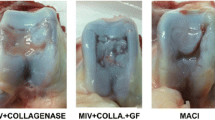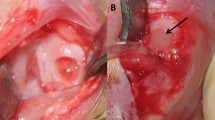Abstract
In this sheep study, we have tested the hypothesis that an osteogenic response is triggered in the subchondral bone by periosteum implanted in full thickness cartilage defects and can be prevented by replacing the periosteum by a cell-free collagen type I/III membrane. Two 7-mm diameter osteochondral defects were made in the trochlea groove and in the medial femoral condyle of one of the knees in each of 15 adult sheep. The animals were divided into three groups (n=5): a control group with untreated cartilage defects, a group treated with autologous chondrocyte transplantation (ACT) and periosteum, and a group treated with ACT in combination with a collagen I/III membrane cover. Histological examination was performed 1 year later. The optical density of the subchondral bone in the histological sections was measured with digital imaging software. There was a dramatic, statistically significant (P<0.0001; power=1) increase in bone density of 45%–70% under defects that were treated with the periosteal cover, compared with the collagen membrane and control groups, which displayed the same bone density. There was no difference in the cartilaginous reparative tissue in the defects in the three groups. Periosteum thus stimulates the remodelling process in subchondral bone. Stiffening of the subchondral bone can lead to degeneration of the overlying reparative cartilaginous tissue because of an increase in the mechanical stress in the tissue. These findings warrant evaluation of subchondral bone changes in patients treated by ACT and the correlation of these changes with clinical outcome.







Similar content being viewed by others
References
Bentley G, Biant LC, Carrington RW, Akmal M, Goldberg A, Williams AM, Skinner JA, Pringle J (2003) A prospective randomised comparison of autologous chondrocyte implantation versus mosaicplasty for osteochondral defects in the knee. J Bone Joint Surg 85-A:223–230
Breinan HA, Hsu HP, Spector M (2001) Chondral defects in animal models: effects of selected repair procedures in canines. Clin Orthop 391:219–230
Brittberg M, Lindahl A, Nilsson A, Ohlsson C, Isaksson O, Peterson L (1994) Treatment of deep cartilage defects in the knee with autologous chondrocyte transplantation. N Engl J Med 331:889–894
De Bari C, Dell’Accio F (2001) Human periosteum-derived cells maintain phenotypic stability and chondrogenic potential throughout expansion regardless of donor age. Arthritis Rheum 44:85–95
Domm C, Schünke M, Christesen K, Kurz B (2002) Redifferentiation of dedifferentiated bovine articular chondrocytes in alginate culture under low oxygen tension. Osteoarthr Cartil 10:13–22
Ehlers EM, Fuss M, Rohwedel J, Russlies M, Kuhnel W, Behrens P (1999) Development of a biocomposite to fill out articular cartilage lesions. Light, scanning and transmission electron microscopy of sheep chondrocytes cultured on a collagen I/III sponge. Anat Anz 181:513–518
Hunziker EB (2002) Articular cartilage repair: basic science and clinical progress. A review of the current status. Osteoarthr Cartil 10:432–463
O’Driscoll SW (1999) Articular cartilage regeneration using periosteum. Clin Orthop 367:186–203
O’Driscoll SW (2001)Technical considerations in periosteal grafting for osteochondral injuries. Clin Sports Med 20:379–402
O’Driscoll SW, Fitzsimmons JS (2000) The importance of procedure specific training in harvesting periosteum for chondrogenesis. Clin Orthop 380:269–278
O’Driscoll SW, Fitzsimmons JS (2001) The role of periosteum in cartilage repair. Clin Orthop 391:190–207
O’Driscoll SW, Saris DB (2001) The chondrogenic potential of periosteum decreases with age. J Orthop Res 19:95–103
O’Driscoll SW, Keely FW, Salter RB (1988) Durability of regenerated articular cartilage produced by free autogenous periosteal grafts in major full-thickness defects in joint surfaces under the influence of continuous passive motion. J Bone Joint Surg 70-A:595–606
Peterson L, Minas T, Brittberg M, Nilsson A, Sjogren-Jansson E, Lindahl A (2000) Two- to 9-year outcome after autologous chondrocyte transplantation of the knee. Clin Orthop 374:212–234
Pineda S, Pollack A, Stevenson S, Goldberg V, Caplan A (1992) A semiquantitative scale for histologic grading of articular cartilage repair. Acta Anat 143:335–340
Radin EL, Rose RM (1986) Role of subchondral bone in the initiation and progression of cartilage damage. Clin Orthop Rel Res 213:34–40
Russlies M, Behrens P, Wuensch L, Gille J, Ehlers EM (2002) A cell-seeded biocomposite for cartilage repair. Ann Anat 184:317–323
Vasara AI, Hyttininen MM, Lammi MJ, Lammi PE, Långsjö TK, Lindahl A, Peterson L, Kellomäki, Konttinen YT, Helminen HJ, Kiviranta I (2004) Subchondral bone reaction associated with chondral defect and attempted cartilage repair in goats. Calcif Tissue Int 74:107–114
Acknowledgments
The authors thank Ann Baumann, Geistlich Biomaterials, for supporting the study and for her assistance in preparing the manuscript.
Author information
Authors and Affiliations
Corresponding author
Rights and permissions
About this article
Cite this article
Russlies, M., Behrens, P., Ehlers, EM. et al. Periosteum stimulates subchondral bone densification in autologous chondrocyte transplantation in a sheep model. Cell Tissue Res 319, 133–142 (2005). https://doi.org/10.1007/s00441-004-1001-8
Received:
Accepted:
Published:
Issue Date:
DOI: https://doi.org/10.1007/s00441-004-1001-8




